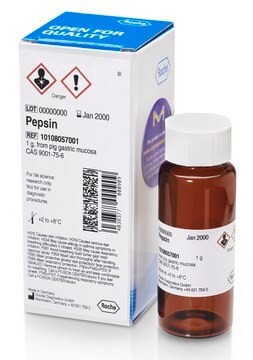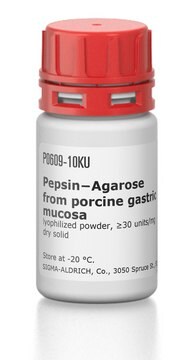P0525000
Pepsin
powder, European Pharmacopoeia (EP) Reference Standard
Sign Into View Organizational & Contract Pricing
All Photos(1)
About This Item
Recommended Products
grade
pharmaceutical primary standard
form
powder
manufacturer/tradename
EDQM
application(s)
pharmaceutical (small molecule)
format
neat
Looking for similar products? Visit Product Comparison Guide
General description
Pepsin powder is prepared from the gastric mucosa of pigs, cattle or sheep.
Application
Pepsin EP Reference standard, intended for use in laboratory tests only as specifically prescribed in the European Pharmacopoeia.
Packaging
The product is delivered as supplied by the issuing Pharmacopoeia. For the current unit quantity, please visit the EDQM reference substance catalogue.
Other Notes
Sales restrictions may apply.
Signal Word
Danger
Hazard Statements
Precautionary Statements
Hazard Classifications
Eye Irrit. 2 - Resp. Sens. 1 - Skin Irrit. 2 - STOT SE 3
Target Organs
Respiratory system
Storage Class Code
13 - Non Combustible Solids
WGK
WGK 1
Flash Point(C)
Not applicable
Choose from one of the most recent versions:
Certificates of Analysis (COA)
Lot/Batch Number
Sorry, we don't have COAs for this product available online at this time.
If you need assistance, please contact Customer Support.
Already Own This Product?
Find documentation for the products that you have recently purchased in the Document Library.
Customers Also Viewed
J Kyle Bohman et al.
Chest, 143(5), 1407-1413 (2012-11-03)
Airway pepsin has been increasingly used as a potentially sensitive and quantifiable biomarker for gastric-to-pulmonary aspiration, despite lack of validation in normal control subjects. This study attempts to define normal levels of airway pepsin in adults and distinguish between pepsin
H Cao et al.
European review for medical and pharmacological sciences, 17(11), 1427-1437 (2013-06-19)
Recently, type II collagen (CII) was found to be effective clinically for treatment of rheumatoid arthritis (RA). However, the molecular properties of CII could be changed during the preparation process. In the present study, we isolated CII from chick sternal
Emily S Foster et al.
Toxicology, 309, 30-38 (2013-04-30)
An association between protein allergenicity and resistance to pepsin digestion in the gastrointestinal tract has been proposed. However, although widely accepted, such an association is inconsistent with known labile allergens and resistant nonallergens. Given the central role of antigen presenting
Hirotsugu Oda et al.
Applied and environmental microbiology, 79(6), 1843-1849 (2013-01-15)
Lactoferrin is an iron-binding glycoprotein found in the milk of most mammals for which various biological functions have been reported, such as antimicrobial activity and bifidogenic activity. In this study, we compared the bifidogenic activity of bovine lactoferrin (bLF) and
Chuan-Hsiao Han et al.
Food chemistry, 138(2-3), 923-930 (2013-02-16)
Our previous report showed that yam dioscorin and its peptic hydrolysates exhibit radical scavenging activities; however, the functions of these peptic hydrolases are still under investigation. In this study, the thiol-containing peptides derived from computer-aided simulation of pepsin hydrolysis of
Our team of scientists has experience in all areas of research including Life Science, Material Science, Chemical Synthesis, Chromatography, Analytical and many others.
Contact Technical Service







